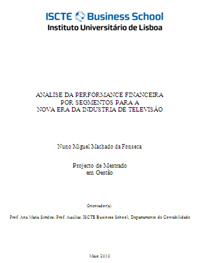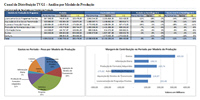 | |||||||||||||
| |||||||||||||
|
|
Master Thesis: Segmented Financial Performance Evaluation for the New Age of Television Industry (15/05/2010) 1 - Introduction 1.1 - Theme Presentation and Justification Television left, undeniably, a mark in the history of the twentieth century. First in black and white and then in color, this media was capable of reaching the masses in a remarkable way. It mobilized millions for both pure entertainment and the witness of unique events in human history, such as the Man arrival on the Moon in 1969. It entertained and informed with such a power and reaching ability that it was many times in history used as political and social influence as well as propaganda instrument. In few decades, television became a business of millions, supporting its business model in air time selling to companies which intend to promote their products and services; a business with its own characteristics which is crossing a critical moment full of new opportunities and threats. In this context, this paper aims to present a model for evaluating the financial performance by segment for the TV industry. However, at a time when the industry is facing numerous challenges, it wouldn't make sense to look only at the traditional business model. Therefore this paper will try to be an exercise pointed towards the future, interpreting trends and looking for answers. In recent decades, television has filled a considerable amount of leisure time devoted to entertainment and news by the majority of modern populations. The characteristics of its management and its business model are, in general, unknown and they differ from most commercial activities based on the production of goods and services. For instance, the broadcast signal is presented as an intangible asset in which the increase of consumers does not represent an additional cost for the broadcaster. This business' characteristics (different from the generality of business) and its public notoriety motivate the study of this issue and demand response to the best metrics capable of evaluating the economic and financial performance of companies in this sector. Moreover, the fact that it is an understudied sector - with regard to its management -, wrapped in creativity and magic, but which is not generally recognized by the latest trends and best practices of management. This last issue brings greater focus and motivation to the study. 1.2 - Paper Problem and Objectives In this essay, the choice fell on studying a model of evaluation and monitoring of economic performance and financial segments of the television industry. The reason for this choice is linked to the perspective from which to discover the real business value generators or destructive levers. To present a model for assessing performance-based segments it is necessary to "dissect" the business, knowing its structure and critical factors. This approach appeared as highly motivating in a business with so many differentiating elements. Being it a sector with very specific features, this paper aims to present its business model, foundations and historical evolution. The purpose is to find the critical business axis and to define the relevant segments to monitor in which performance should be evaluated. Among the goals of this paper there are also the management accounting, in relation to the model for allocating income and expenses to the segments identified, and the management control as a key agent in implementing the model. It is also an objective to further provide the specifics of the management control in television and the accounting treatment to be given to television programs. In order to achieve the identified goals, the main theoretical and conceptual subordinate themes will be introduced, especially management control and financial reporting organization. Most commonly advocated financial KPI's by segment will also be introduced with the purpose of electing the most capable of meeting the proposed goals, namely to assess the value creation for television companies. The new challenges facing this business will also be further studied and analyzed. The changes in consumer behavior, the changing factors, the threats and the survival in the new environment will be part of this document objects. This paper intends to propose a structure for the organization of financial information for broadcasting television companies with the aim of presenting a model for assessing economic and financial performance by segment, future-oriented and able to respond to new challenges in the sector. 1.3 - Research Methodology and Methods This document was developed based on a qualitative methodology resulting from the direct collection of data and author direct contact with the reality along ten years of professional experience in the business. Throughout this period it was possible to the author to come into contact with various TV companies in several countries with different structures and objectives. To achieve these goals the method of investigation of the case study has been adopted. The case study is considered the most appropriate method when we want to analyze contemporary events and present a proposal for management practices in order to solve new needs or boundaries of current practices. This study presents a proposal of financial information organized to the television industry in a way such as to the evaluation and monitoring of economic and financial performance at the management relevant segments. The techniques of data collection resulted mainly from direct observation, documentation collection and informal conversations with managers and other stakeholders of the television industry. The author's knowledge and experience in the business and in the industry were also relevant to identify key needs and proposal solutions. 1.4 - Document Structure The structure of this document attempts to be consistent with the logic of the various targets to which it is proposed, making the path from the theoretical basis (chapter 2), through the approach of the characteristics of the television industry and its business model (Chapter 3), looking towards the future (Chapter 4) - by analyzing the evolution of the industry and its environment, trends, ongoing changes and seeking answers to value creation in the new context. Finally, a model is proposed (Chapter 5), supported in the theoretical foundations introduced, considering the characteristics of the business and its future. |
|
|||||||||||
nunofonseca.com - All rights reserved.


